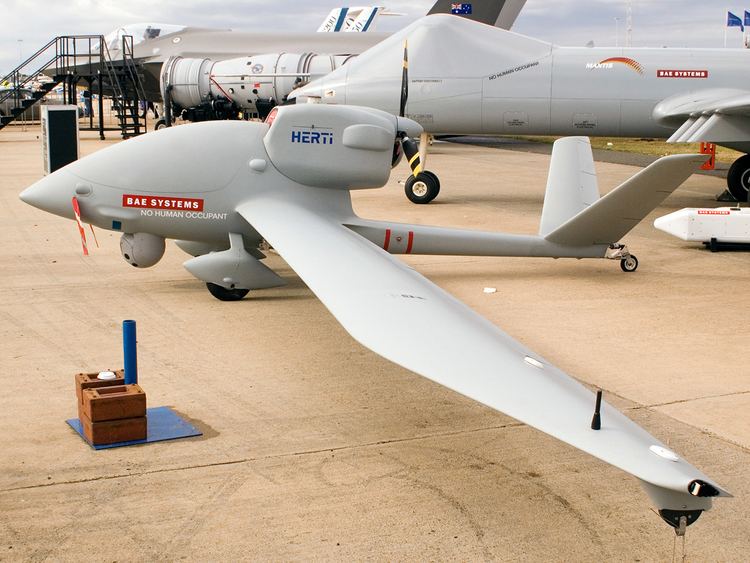Length 5 m | Wingspan 12 m | |
 | ||
The BAE Systems HERTI is an unmanned aerial vehicle (UAV) developed by the British company BAE Systems. HERTI stands for "High Endurance Rapid Technology Insertion" and was developed in Warton, United Kingdom. The HERTI airframe is based on a motor glider designed by Jaroslaw Janowski of J&AS Aero Design, Poland. Its first flight was in December 2004 at the Australian Woomera test range where much of the test flight programme has been undertaken. HERTI was also the first UAV to fly in the UK with the flight being certified by the United Kingdom Civil Aviation Authority.
Contents
- Australia
- United Kingdom
- Operational debut in Afghanistan
- Military and other uses
- Variants
- Future developments
- Specifications HERTI OC
- References
The first vehicles had a maximum takeoff weight of 450 kilograms (990 lb) and a payload of about 150 kilograms (330 lb). However the first production example will, according to Flight International, weigh about 750 kilograms (1,650 lb). The first production example will be delivered by Slingsby Aviation to BAE Systems at the end of November 2007. The endurance of the production variant is up to 20 hours.
An armed version, the BAE Fury, was announced in 2008.
Australia
The HERTI UAV started flight trials in Australia in late 2004. Since then, quite a few key points have been addressed, however, slightly slower than BAE Systems wanted to. The two main test centres are the Woomera range in central Australia and the West Sale airbase which is in south-east Australia. In late 2006 a HERTI vehicle flew several fully autonomous missions from the Woomera test centre to expand the flight envelope, or distance and height limits to which the UAV has flown in real tests. In mid-2007 BAE Systems started a flight campaign to increase the flight envelope even further, this time from West Sale airbase. In these trials the HERTI UAV should fly 28 km from base and at altitudes of about 1,830 metres (6,000 ft) To achieve a UAV that can safely fly within civilian airspace, BAE Systems is developing a "sense and avoid" system for HERTI, utilising a radar and electro-optical systems.
United Kingdom
The relatively few flight tests undertaken in the UK have been done over the Machrihanish bay, flying from Campbeltown Airport. Due to these flights in 2005, BAE Systems claims that it was the first UAV to fly in the UK with a CAA certification.
Operational debut in Afghanistan
Under Project Morrigan, BAE Systems deployed a HERTI UAV to Afghanistan where it flew missions from Camp Bastion. Specific mission profiles are still Classified information, however the system did send data back to the UK in a procedure called "reach back" and BAE Systems claims that the deployment was a success. The Royal Air Force said that the HERTI was successful "in demonstrating its capability in an operational environment".
Military and other uses
Currently BAE Systems is showing the HERTI to potential customers at various air shows, such as the Farnborough Airshow, Dubai Air Show and others. The potential for HERTI use by the British police and border control forces has been mentioned. Other potential fields of application for HERTI and other UAVs are the oil and gas industry, traffic control, coastal protection, search and rescue and many more.
Variants
Future developments
Specifications (HERTI-OC)
General characteristics
Performance
Avionics
Information and Exploitation Systems based on 3 x Radstone Computers
